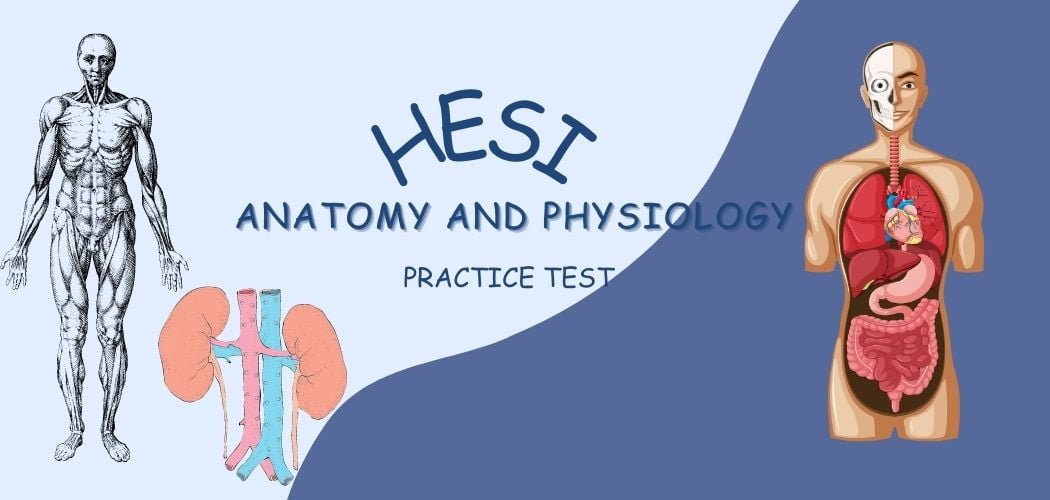The HESI Biology test consists of 25 multiple choice questions which must be answered within 25 minutes. Questions will cover your knowledge of basic biology, including biological molecules, water, cellular energy production, cellular reproduction, DNA, metabolism, and genetics.
This free HESI biology practice test includes 50 questions to assist with your test prep, review, and see if you’re ready for the real deal.
HESI Biology Practice Test
These HESI biology practice questions have the same format and blueprints that mirror actual credentialing exams.
Question 1. Proteins are polymers composed of?
A. Fatty acids
B. Sugars
C. Nucleotides
D. Amino acids✅
Question 2. What type of bond links amino acids together within the primary structure of a protein?
A. Hydrogen
B. Covalent✅
C. Ionic
D. Hydrophobic
Question 3. Which nucleotide base is found within DNA but not in RNA?
A. Thymine✅
B. Uracil
C. Adenine
D. Cytosine
Question 4. Glucose is a common monomer of
A. Proteins
B. Nucleic acids
C. Phospholipids
D. Carbohydrates✅
Question 5. What is the type of bond between the O atom and each H atom within a water molecule called?
A. Covalent✅
B. Hydrogen
C. Ionic
D. Hydrophobic
Question 6. What property allows refers to the ability of water molecules to stick to each other?
A. cohesion✅
B. adhesion
C. specific heat
D. density
Question 7. Which statement describes the relationship between the densities of ice and liquid water?
A. Ice has a higher density than liquid water.
B. Ice has a lower density than liquid water.✅
C. Ice has the same density as liquid water.
D. There is no consistent relationship between the densities of ice and liquid water.
Question 8. What type of bond forms between water molecules that allow them to stick to each other?
A. Covalent
B. Hydrogen✅
C. Ionic
D. Hydrophobic
Question 9. Which cellular structure is found in a typical eukaryote but not in a prokaryote?
A. Cell membrane
B. DNA
C. Ribosome
D. Mitochondrion✅
Question 10. Which step of the scientific method occurs before the development of a hypothesis?
A. Experiment
B. Make Observation✅
C. Collect Data
D. Draw Conclusion
Question 11. Which of the following is an example of an anabolic pathway?
A. Making a protein from amino acids✅
B. Converting starch into glucose molecules
C. Degrading DNA into nucleotides
D. Digesting fats to fatty acids
Question 12. What type of molecule are hormones like testosterone and estrogen?
A. Proteins
B. Nucleic acids
C. Lipids✅
D. Carbohydrates
Question 13. What organelle of a eukaryotic cell is important for modifying proteins and then packaging them into membrane-bound vesicles for transport and secretion?
A. Smooth endoplasmic reticulum
B. Rough endoplasmic reticulum
C. Ribosomes
D. Golgi apparatus✅
Question 14. Which eukaryotic organelle digests foreign materials like viruses by phagocytosis?
A. Lysosome✅
B. Mitochondrion
C. Nucleus
D. Golgi apparatus
Question 15. Which statement best describes the hydrophobic part of a cell membrane?
A. The membrane interior is composed of fatty acids✅
B. The membrane exterior is composed of fatty acids
C. The membrane interior is composed of phosphate head groups
D. The membrane exterior is composed of phosphate head groups
Question 16. Which organelle likely arose as a result of the endosymbiosis of a bacterium inside of a primitive eukaryotic cell?
A. Vacuole
B. Nucleus
C. Ribosome
D. Mitochondrion✅
Question 17. Which molecule passes through the cell membrane by simple diffusion?
A. Glucose
B. Insulin
C. O2✅
D. Na+
Question 18. During cellular respiration, which process results in the degradation of Acetyl-CoA to CO2?
A. Krebs cycle✅
B. Calvin cycle
C. Glycolysis
D. Oxidative phosphorylation
Question 19. How many net ATP molecules are made per glucose molecule during glycolysis?
A. 0
B. 2✅
C. 4
D. 38
Question 20. Where is the electron transport chain located in a eukaryotic cell?
A. Cell membrane
B. Rough endoplasmic reticulum
C. Outer mitochondrial membrane
D. Inner mitochondrial membrane✅
Question 21. Which of the following is a product of photosynthesis?
A. Light
B. O2✅
C. CO2
D. H2O
Question 22. Which type of organism is a prokaryote?
A. Protozoa
B. Fungi
C. Bacteria✅
D. Viruses
Question 23. Which level of biological organization is the smallest unit of structure that is considered to be alive?
A. Organelle
B. Cell✅
C. Organ
D. Population
Question 24. Which level of biological organization is the smallest unit that can evolve?
A. Cell
B. Organism
C. Population✅
D. Community
Question 25. Which list has the levels of a biological organization correctly ordered from smallest to largest?
A. Molecule, Organelle, Cell, Tissue, Organ, Organism, Population, Community, Ecosystem✅
B. Molecule, Cell, Organ, Organelle, Tissue, Organism, Population, Ecosystem, Community
C. Organelle, Cell, Tissue, Organ, Molecule, Organism, Population, Community, Ecosystem
D. Organelle, Molecule, Cell, Organ, Tissue, Organism, Ecosystem, Population, Community
Question 26. During which photosynthetic process is CO2 fixed into organic carbon?
A. Photosystem I
B. Photosystem II
C. Krebs cycle
D. Calvin cycle✅
Question 27. During which phase of the eukaryotic cell cycle does DNA replication occur?
A. G1 phase
B. S phase✅
C. G2 phase
D. M phase
Question 28. Consider the cell cycle. If a cell has 10 picograms of DNA during the G2 phase, how much DNA does it have during the G1 phase?
A. 5 picograms✅
B. 10 picograms
C. 20 picograms
D. 40 picograms
Question 29. During which stage of meiosis does crossing over occur?
A. Anaphase I
B. Metaphase II
C. Prophase I✅
D. Telophase II
Question 30. During which stage of meiosis does the separation of homologous chromosome pairs occur?
A. Anaphase I✅
B. Metaphase II
C. Anaphase II
D. Prophase I
Question 31. Which process do prokaryotes use for cell division?
A. Mitosis
B. Meiosis I
C. Meiosis II
D. Binary Fission✅
Question 32. Consider a cell undergoing meiosis. Which best describes the cells resulting from meiosis I?
A. 2 diploid cells with each chromosome composed of 2 sister chromatids
B. 2 haploid cells with each chromosome composed of 2 sister chromatids✅
C. 2 haploid cells with each chromosome being 1 double-stranded DNA molecule
D. 4 haploid cells with each chromosome being 1 double-stranded DNA molecule
Question 33. How many pairs of autosomes do humans have?
A. 22✅
B. 23
C. 44
D. 46
Question 34. If an individual heterozygous for a gene mates with an individual who is homozygous recessive for the same gene, what is the probability that their offspring will be homozygous recessive?
A. 100%
B. 50%✅
C. 25%
D. 0%
Question 35. If the A allele is completely dominant to the A allele, which groups of genotypes will result in an individual having the dominant phenotype?
A. AA and aa
B. Aa and aa
C. AA and Aa✅
D. AA, Aa, and aa
Question 36. Cystic fibrosis is an autosomal recessive disease. If two individuals who do not suffer from cystic fibrosis but each carry the allele associated with the disease have children, what is the probability that they will have a child having cystic fibrosis?
A. 100%
B. 50%
C. 25%✅
D. 0%
Question 37. Which term refers to an individual’s observable characteristics resulting from what genes it has as well as environmental influences?
A. genome
B. haplotype
C. genotype
D. phenotype✅
Question 38. If two individuals both having the genotype AaBb are crossed, what proportion of their offspring do you expect to have the dominant A phenotype combined with the recessive b phenotype?
A. 9/16
B. 1/4
C. 3/16✅
D. 1/16
Question 39. What term refers to 2 chromosomes that have the same genes in the same order but not necessarily the same alleles of each gene?
A. Homologous✅
B. Nonhomologous
C. Homozygous
D. Heterozygous
Question 40. Within a double-stranded DNA molecule, what type of bond links nucleotides within a strand of DNA to each other?
A. Hydrogen bonding between the nitrogenous bases.
B. Covalent bonding between the phosphate of one and the sugar of another.✅
C. Hydrophobic bonding between nitrogenous bases.
D. Ionic bonding between the phosphate of one and the sugar of another.
Question 41. Within a double-stranded molecule of DNA, if 20% of the nucleotides contain A, what percentage of nucleotides contain C?
A. 20%
B. 30%✅
C. 40%
D. 60%
Question 42. Where does transcription occur in a eukaryotic cell?
A. Rough endoplasmic reticulum
B. Smooth endoplasmic reticulum
C. Cytoplasm
D. Nucleus✅
Question 43. Which of the following is the chemical formula for a carbohydrate composed of 12 carbons?
A. C12H24O24
B. C12H12O24
C. C12H24O12✅
D. C12H18O18
Question 44. Which type of atom is found in both proteins and nucleic acids, but not in fats or carbohydrates?
A. N✅
B. P
C. O
D. S
Question 45. Which of the following is a DNA sequence that signals the initiation of transcription?
A. Origin
B. Promoter✅
C. Start codon
D. Primer
Question 46. Which of the following molecules is involved in transcription but not in translation?
A. Ribosome
B. mRNA
C. DNA✅
D. Amino acids
Question 47. Which level of protein structure refers to the association of the various subunits of a multi-subunit protein into a three-dimensional functional protein?
A. Primary
B. Secondary
C. Tertiary
D. Quaternary✅
Question 48. Which molecule contains 3-nucleotide groupings called codons which each code for a specific amino acid?
A. mRNA✅
B. tRNA
C. rRNA
D. DNA
Question 49. Transcribe the following DNA template: 3′-TACGGTACCATG-5′
A. 5′-ATGCCATGGTAC-3′
B. 5′-AUGCCAUGGUAC-3’✅
C. 5′-CAUGGUACCGUA-3′
D. 5′-GTACCATGGCAT-3′
Question 50. Which structure or enzyme complex is responsible for linking together nucleotides during the process of replication?
A. RNA polymerase
B. DNA polymerase✅
C. Ribosome
D. Primaseic



